 |
|
|
 |
2004
July
31
|
Punctuation / Cell phones
Book of the day: Eats, Shoots, and Leaves,
which is (of all things) a funny bestselling book about punctuation.
The author's main point is of course that you can use punctuation either to make yourself clear
or to make yourself unclear, and the results of the latter are often amusing.
Click on the link to see the book's web site and read an excerpt.
It's as entertaining as P. G. Wodehouse.
(The title alludes to a joke about a panda. The panda eats shoots and leaves. It does not eat, shoot,
and leave.)
CAN YOU HEAR ME NOW? ...
While in Atlanta I had an insight into one of the things the public doesn't know about cell phones.
People don't know that audio amplifiers really work.
The loudness of the signal in the cell phone is automatically adjusted for you.
Yelling won't make your words louder in the other person's ear.
It will just annoy the people around you.
HELLO! HELLO? HELLO??? YOU'RE CUTTING OUT!
Nor will yelling overcome a bad connection.
With a cell phone, a bad connection makes the sound choppy, not weak, and stentorian voices
will not break through the choppiness.
I know this goes against all the experience we've had with conventional telephones for
the past 130 years or more, but trust me. You never need to yell into a cell phone.
And above all, yelling won't make the other person's voice louder.
For that, use the volume control on your own cell phone. It's there... on a Nokia,
for instance, just press the up or down button during a call.
DEE-DEE-DOOT-DOOT-DEE-DEE-DOOT-DEE-DEE-DOOT-DOOT-DOO!
Now if we could just do something about those ringers!
Some theaters and concert halls have resorted to jamming cell phone signals, which is illegal in
the United States and could be quite dangerous in an emergency.
(What better place to take hostages?)
I'd like to see a different technology deployed instead.
Cell phones should be programmed to respond to short-range transmitters
that tell them to silence the ringer and, in extreme cases, even block non-emergency calls.
There should be a way to override this in cases of misuse, and the transmitters would need to be licensed.
But it's better than banning the use of cell phones altogether.
And above all, we need to give a few people some wise words about audio amplifiers,
and about the fact that we can hear them even if the telephone system can't!

|
 |
2004
July
29-30
|
Back home...
Just back from giving Melody a surprise 2-night vacation in Atlanta to celebrate our
anniversary.
We got a $225 hotel room for $59 a night through
www.quikbook.com.
More news later.

|
 |
2004
July
26-28
|
The Science of Radio, or, how to teach engineering
I've just been reading, with great enjoyment,
The Science of Radio,
by Paul Nahin.
This is a very entertaining mix of technological history with electromagnetic theory.
Its goal?
To enable second-year engineering students to understand how an AM radio works.
The author argues - and I agree - that engineering students today aren't taught how anything works.
Customarily, they're taught lots of theory for which they have no applications,
followed by applications for which they have no theory.
And much of this is delivered in "weed-out courses," which I deplore - courses that are excessively hard
(or badly taught) for the explicit purpose of flunking out some of the students.
And then we complain about the shortage of well-trained engineers,
and the fact that new graduates often don't seem to know what they're doing.
I think that in studying science, mathematics, or technology, it's vital to know
how things were discovered and how people in the past actually faced puzzling problems.
Science didn't spring full grown from the pages of a textbook.
People had to discover and invent things.
It's unreasonable to expect a modern scientist or engineer to make discoveries when you haven't told him
how anybody discovered anything in the past.
I also think that a lot of people who could be making creative inventions in other fields are
diverted into software simply because computer programming still involves a
strong sense of creativity and craftsmanship.
We haven't forgotten the 1980s, when everybody was a programmer.
And ordinary computer usage still gives people a taste of programming.
The transition from user to programmer is much easier to make, nowadays,
than the transition from radio listener to electronic engineer!
Enjoy The Science of Radio. Maybe it's the first of a new genre.
I'm going to be out of town for a few days and not posting blog entries. See you July 31.

|
 |
2004
July
25
|
22nd Anniversary
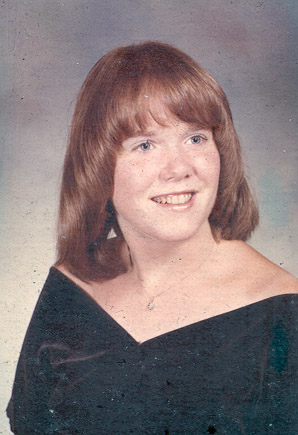 Twenty-two years ago today, July 25, 1982,
Melody and I got married at her church in Winder, Georgia.
We have been (and still are) a very happy couple.
Actually, neither of us could imagine being married to anyone else.
Twenty-two years ago today, July 25, 1982,
Melody and I got married at her church in Winder, Georgia.
We have been (and still are) a very happy couple.
Actually, neither of us could imagine being married to anyone else.
We have been best friends even longer than we've been married.
Here is the history of how we met.
In October 1972, I visited The University of Georgia as a high-school
student in line to get a National Merit Scholarship.
That day (I think it was the 28th) I decided to come to Georgia rather
than some other university (actually, my alternative plans were very vague).
And on November 8, 1975, I attended the same annual event again as a
University of Georgia student, to help recruit more National Merit
Scholars. [Details of a correction
here.]
It was early in the morning; we were in the lobby outside the Law School
Auditorium, and the visiting students were coming in, most of them
accompanied by entourages of parents, kid brothers, etc.
Over in the corner was a nice-looking girl who had no entourage.
I saw my duty to the University and did it.
She introduced herself as Melody Mauldin, of Winder, Georgia,
and I took good care of her all day.
Then she went back to Winder and we wrote letters to each other
(admittedly a primitive technology, but in those days there was no e-mail,
and even a phone call over that short distance cost about 25 cents per minute).
We started dating in May of 1976 after she arranged to meet me
on two subsequent visits to the University.
Then I looked at a map, found that Winder was much closer
than I had thought, and pursued the opportunity.
Here you see Melody's high-school portrait, which I've carried in my wallet
since 1976, although I've digitized it a couple of times just in case the
original deteriorates or is lost.
Recently, reading one of these Reader's Digest articles on
how to have a successful marriage,
Melody and I concluded that we had a successful marriage
by the end of our first or second date.
The immature stages that people talk about just didn't happen;
no games, no manipulation, no rivalry.
(Maybe we had a good marriage even before we met, and we
were each waiting for the other half of it to come along!)
We were best friends from the start,
as well as lovers,
and it gradually
became evident that neither of us could ever marry anyone else!
We were at Georgia together for a year (1976-77), and then Melody
patiently endured five years of intermittent separation while I was at
Cambridge and Yale.
By then we were sure we were a permanent couple.
We got married in 1982 and spent our honeymoon driving to Los Angeles,
where I took up a postdoctoral fellowship at USC.
In 1984 we came back to Georgia; Cathy and Sharon were
born in 1985 and 1988 respectively.
And, as they say, "the rest is history."
I should add that we didn't live together or "fool around" before the wedding.
Our wedding night really was our wedding night.
We both believe very strongly that if you don't have sexual
self-discipline before marriage, you won't have what you need within
marriage either.
And neither of us can imagine being bonded to anyone else.
We're not two people who just happen to be together;
we're (as the Bible puts it) one creature.

|
 |
2004
July
22-24
|
Ach, Donnerwetter!
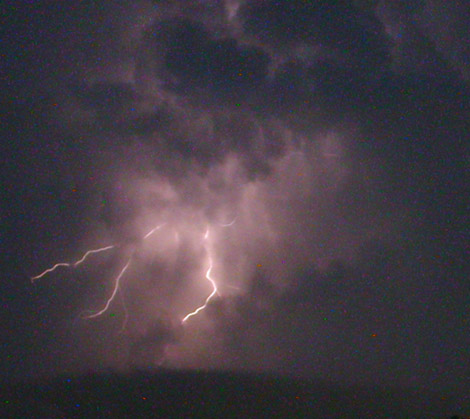 I'm on vacation this week and not writing blog entries regularly, but here's
tonight's photographic triumph.
There was an intense thunderstorm about 30 miles south of us, but no lightning
in the immediate area - hence a good opportunity to watch a thunderstorm without
being more directly involved than I would want!
I'm on vacation this week and not writing blog entries regularly, but here's
tonight's photographic triumph.
There was an intense thunderstorm about 30 miles south of us, but no lightning
in the immediate area - hence a good opportunity to watch a thunderstorm without
being more directly involved than I would want!
Sheltered by the carport, I put the Nikon Coolpix 800 on a small tripod and rested it
on the trunk of my car, then took 8-second auto-exposures (flash turned off, of course)
one after another. This is the best of the lot.
The pictures were speckled with red, green, and blue starlike points caused by hot pixels.
Median-filtering the image and reducing it to half size got rid of them.
In the "Who'd 'a' thunk it?" category: I've recently learned that the electronics repair
industry is plagued by
counterfeit transistors.
They're aided by the fact that there is no nondestructive way to test the maximum
power that a transistor can handle.
But cracking open the case can be very revealing!
Speaking of electronics, I've been browsing through two new Cambridge University Press books,
Scott Hamilton's Analog Electronics Companion
and Thomas H. Lee's The Design of CMOS Radio-Frequency Integrated Circuits.
The Hamilton book is a set of essays on interesting topics that bridge the gap between electronics and physics.
(Its blurb is misleading; it's not for beginners!
Unless you know how to handle both op-amps and partial derivatives, you'll find parts of it too advanced.)
The Lee book, despite its title, is actually an entertaining ramble through all of RF electronics,
including lots of history. (Read it for the digressions!)
Neither of these is quite on the level of the two best electronics handbooks ever written,
Horowitz and Hill's The Art of Electronics
(which has its own web site)
and RCA's much earlier Radiotron Designer's Handbook
(more information here).

|
 |
2004
July
21
|
Another way to confuse Windows
Today I was in the lab, moving back and forth between two computers with roaming user
profiles, and I kept running into odd problems.
Files created on the desktop of one computer never appeared on the other.
My desktop wallpaper didn't roam with me.
My Opera bookmarks and settings on the two computers were completely separate,
and Opera gave a strange "M2 error" when I logged in.
(And no, I wasn't logged onto both computers at once. I made sure to do a proper
logoff from each before logging on the other.)
The problem?
My profile wasn't in the same directory name on the two computers.
It was
C:\Documents and Settings\mc
C:\Documents and Settings\mc.AI.002
on the two computers, respectively.
How did this happen?
Apparently, on one computer, I had, at various times, failed to log off successfully
(due to crashes, network failures, etc.), and then the next time I came along, Windows
generated a new directory to copy my profile into.
That's how I got:
C:\Documents and Settings\mc
C:\Documents and Settings\mc.AI
C:\Documents and Settings\mc.AI.001
C:\Documents and Settings\mc.AI.002
in succession. All of these existed, and the last one is the one my profile was actually copied into.
What to do?
I logged on as administrator and deleted all the directories for user mc
(which is me, as a roaming user).
And for now, I've inserted code into our logon script to detect and report the problem
by checking whether %USERPROFILE% ends with the same characters as %USERNAME%.
Here's the VBSCRIPT code:
Set Shell = WScript.CreateObject("WScript.Shell")
uprof = Shell.ExpandEnvironmentStrings("%USERPROFILE%")
uname = Shell.ExpandEnvironmentStrings("%USERNAME%")
if Right(uprof,Len(uname)) <> uname then
MsgBox _
"You have multiple profiles on this computer." + vbCRLF + vbCRLF + _
"Please get the system administrator to delete them.", _
16, _
"Multiple Profiles Found"
end if
That's all I know to do just at the moment. We'll see if the problem recurs.
I actually think this is a subtle bug in Windows.
The reason?
There are times when it's normal for a user's profile to be stored under different directory names as the
user roams from computer to computer.
Maybe one of the PCs has a local account with the same name as the user, and the other one doesn't.
Maybe one of the PCs stores profiles in a different place than the others.
Yet even Windows gets confused here; it's not just Opera Browser.

|
 |
2004
July
20
|
Against electronic voting machines
Today I voted in a primary election using the infamous Diebold electronic
voting machines.
I think computerized voting machines are a rotten idea.
Votes should not be counted by a machine that human eyes cannot inspect.
The inner workings of a computer are not visible to human eyes and,
for security reasons, not even inspectable by a computer programmer.
(And anyhow, it isn't feasible to audit a machine's entire firmware on short notice;
it's just too much work.)
Diebold's answer? "You just have to trust us."
With a conventional voting machine, there are mechanics in any town who can
verify that the machine works as advertised.
What's more, the mechanism is simple enough that it can't be rigged
to do anything subtle.
It works or it doesn't work.
Not so the computer.
A microprocessor can be programmed to throw an election in any way imaginable,
such as waiting until 1000 votes have been cast, and then pseudo-randomly throwing
one vote out of every ten, but only if the second candidate is leading.
There's no way a brief test could detect that.
Diebold's answer (again)? "You just have to trust us."
Pardon me, but I don't trust you. Why should we entrust our elections to a private
company - or whoever can get at the company's technicians?
I actually like the Florida punch-card ballots that were so controversial in 2000.
Yes, there were some problems, but at least we had something to re-count!
As for Florida's "hanging chad" problem, it's the voter's responsibility to turn
in a legible ballot. "Hanging chad" is not a problem with the voting machines;
it's a problem with voters who didn't look at the ballots after punching them.
But today I don't even know if I cast a secret ballot, for two reasons.
First, there were no curtains around the voting machines.
Anyone looking over my shoulder could easily have seen my votes.
Second, the voting machine itself inspires distrust.
Before I voted, a poll worker gave me a "smart card" on which she had just
encoded a number to tell the machine whether to display the Democratic or
Republican ballot.
I had to insert this card into the machine in order to vote.
How do I know my vote wasn't also recorded on the "smart card"
and then linked to my identity by the poll workers?
I don't think this actually happened, but it would have been easy to do.
In short: Electronic voting machines discard democracy for convenience.
Away with them!
 Update, 9:51 p.m.: Look carefully at this election result,
which is apparently going to require two runoffs.
Update, 9:51 p.m.: Look carefully at this election result,
which is apparently going to require two runoffs.
Will everyone still trust Diebold's machines now?
Remember, there's nothing to re-count - the computers have already made the decision!
(Image from athensclarkecounty.com, a governmental web site.)
Update, 11 p.m.: Those weren't actually the final numbers. Although the web site
indicated all precincts reporting, there were actually a few more votes. Only one runoff
will be needed.
Update, July 30: They're having a re-count anyway. I'm not at all sure what is being
counted; maybe the voted recorded on the smart cards?

|
 |
2004
July
18-19
|
Confessions of a presbyopic astronomer
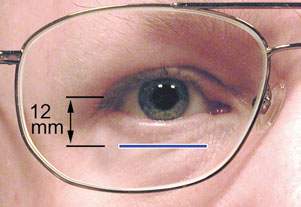 Like most people over 45 years old, I suffer from presbyopia, which means
that the lenses of my eyes have lost most of their focusing range.
This is not a disease; it's a natural result of aging.
Many presbyopia sufferers don't realize what's happening; they conclude
that their "eyes are growing dim" or that they're going blind.
Like most people over 45 years old, I suffer from presbyopia, which means
that the lenses of my eyes have lost most of their focusing range.
This is not a disease; it's a natural result of aging.
Many presbyopia sufferers don't realize what's happening; they conclude
that their "eyes are growing dim" or that they're going blind.
If my vision had been normal in the first place, all I'd have to do is wear
reading glasses when doing close work.
But I started out severely nearsighted (and still am).
My eyeglass prescription is about -5, which means that without glasses,
my eyes focus at 1/5 meter (about 8 inches).
That's too close even for reading a book of normal size.
So until recently, I wore glasses with simple negative (-5) lenses, and that was that.
But then, presbyopia set in.
And to complicate matters further, I'm an amateur astronomer.
So right now I have several kinds of glasses on hand:
- Distance glasses that focus at infinity and are usable, in my present state,
down to about 3 feet.
- Reading glasses that focus at 0.5 meter (20 inches), give or take a bit.
I wear these for prolonged computer work and reading.
- Conventional bifocals. These didn't suit me at all and I no longer wear them,
largely because of the impossibility of doing computer work without craning my neck backward.
The computer is straight ahead of me - not down below - yet it's close.
- Varifocal (gradient) bifocals. These focus at a wide range of distances depending
on which part of the lens I'm looking through. I wear these most of the time,
but they work well only in bright light, when the pupils of my eyes contract to 2 mm or
smaller. In dim light, the image is blurry in all directions.
- Astro-bifocals (depicted above). These are bifocals with the near-vision
segment extra small and low (12 mm below the center). The distance-vision segment is big
enough to clear the whole field of any eyepiece (up to 65 mm apparent field).
The near-vision segment is just big enough to see the controls of my telescope
or a small star chart.
- I can also use a magnifying glass to bring charts or controls into focus
while wearing distance glasses.
I should explain that the
reason Grandpa uses a magnifier is not to make things look bigger - it's to bring them
into focus. You don't need much magnification. The main purpose of a magnifying glass
is to vary the focal distance of the image.
But, for optical reasons, magnifiers can't be more than about 4 inches in diameter.
My usual one is a Bausch and Lomb 2x3-inch with a built-in light, which I have replaced
with a red LED to save my night vision.
And when observing, I have to be able to see:
- The sky itself to assess general sky conditions and get oriented;
- The view through the eyepiece of the telescope.
This can easily be focused to adjust for refractive error;
- The view through the finderscope, which is semi-permanently focused
for distance vision;
- Star charts and telescope controls of various sizes;
- The control box of my computerized telescope, which requires both hands
(one to hold it, the other to press the buttons), so it can't be viewed through a magnifier.
So how do the various kinds of eyeglasses work?
- No glasses: Ideal for looking through the telescope eyepiece.
(I have no astigmatism; if my eyes were astigmatic, I'd have to wear glasses
even when looking into the telescope.)
Not suitable for looking through the finderscope (unless I modify it),
looking at the sky directly, or using large star charts. OK for small charts,
telescope controls, and the control box.
Some risk of tripping over equipment in the dark because I'm so nearsighted.
- Distance glasses: Ideal for direct viewing of the sky, as well as
looking through the telescope and finderscope.
Small charts and telescope controls can be viewed with a magnifier.
Large charts and the handheld control box are a problem.
- Reading glasses: Surprisingly good; I can't see the sky directly,
and the finderscope would have to be refocused, but charts (even large ones), telescope controls,
the control box, and the view through the telescope are fine.
- Conventional bifocals: Good for everything except looking through the telescope
(where they give double images). OK for the finderscope, where blurring and doubling at
the lower edge of the field can be ignored. Excellent for charts and controls.
For many people, the best compromise is probably to wear conventional bifocals and
take them off when looking into the eyepiece.
- Varifocals: I often wear these when doing astrophotography because they give
usable (not top-quality) views at all distances, making it easy to manipulate equipment.
Direct viewing of the sky is poor except through the topmost part of the lenses.
The view through eyepieces, including cameras and finderscopes, is acceptable for
rough work (centering an object, etc.) though not for critical observing.
Star charts of all sizes are easy to use.
- Astro-bifocals: Excellent for everything except star charts. Small charts
can be viewed with a magnifier, as with distance glasses. The near-vision segment of
the astro-bifocals is ideal for the handheld control box. Otherwise I'd wear distance glasses.
So there you have it. Perhaps by the time I'm old enough to need cataract surgery,
the surgery will also cure presbyopia. The idea is to replace the lens of the eye with
a flexible one like the lens of a young eye. Lenses that do this are already on the
market, but they reportedly give a good image only over the central 4 mm, which is
fine for everyday vision but not for astronomy. They've only been out a few years,
and I figure I won't need them for 20 years or so. By then, though, they'll be tempting
as a cure for presbyopia even if I don't have cataracts.

|
 |
2004
July
17
|
Terminal Server install mode
Problem: You're trying to install software (or Windows Updates) on a computer
that is running Windows Terminal Server. You get the error message:
Terminal server must be in install mode...
This happens even if you are logged on at the computer's own keyboard and screen
(not coming in through Terminal Server).
Explanation:
Under Terminal Server, users (even administrators, even when using the main keyboard and screen) do
not have permission to install software.
There are two ways to get this permission (assuming that, as administrator, you are eligible for it):
- Install the software through Control Panel, Add/Remove Programs; or
- Go to a command prompt and type: change user /install
More about this here
and here.
It has to do with how Windows handles user-specific registry entries for multiple users;
the second link explains it (a little).

|
 |
2004
July
14-16
|
A telescope eyepiece
 I've been busy... but last night was the first clear night in many weeks, and I was finally able
to get my telescope out and try out a new eyepiece that I bought about 6 weeks ago.
I've been busy... but last night was the first clear night in many weeks, and I was finally able
to get my telescope out and try out a new eyepiece that I bought about 6 weeks ago.
It's an Orion Optiluxe 40mm in a 2-inch barrel,
and I give it high marks.
Actually, I owned one of these a while back, sold it, bought a much more expensive
40mm Pentax XL, sold that, and have just bought another Optiluxe.
With a larger telescope, the Pentax would have an advantage.
With my 8-inch f/10 Schmidt-Cassegrain, though, the image quality outside the central 50% of the field
is limited by the telescope, not the eyepiece.
Neither the Pentax nor the Optiluxe is sharp all the way to the edges - but both are quite usable and quite
similar to each other.
Eye relief (eye-to-eyepiece distance) is a comfortable 22 mm or so.
Why a 2-inch barrel? For a wider field. You can get 40-mm eyepieces in a 1 1/4-inch barrel, covering only
the sharp central area. But I figure I might as well see stars farther away from the center, even if they're
not pinpoint-sharp.
Most telescopes only form a sharp image over an area an inch in diameter or less. Unlike a camera lens,
a telescope is designed to be as sharp as possible at the center of the field (permitting high magnification)
but not to cover a wide field. A camera lens, by contrast, is designed to be reasonably sharp over the whole
area of the film, at a fixed magnification, and is not necessary all that sharp if you add magnification with
a teleconverter.

|
 |
2004
July
13
|
Windows updates / A glimpse into an odd mind
If you haven't already done so, please
download critical Windows updates today.
Quite a few have just been released.
CNET reports
that a British teenager is claiming wrongful arrest after conducting a denial-of-service attack on his former boss.
He sent the boss about 5 million e-mails, rendering the system unable to handle any other mail and
causing substantial loss of business.
Apparently he does not deny that his intent was to cause harm.
Rather, reasoning mechanically, he argues that if it's OK to send one e-mail, it's OK to send 5 million,
regardless of the consequences.
I once got a similar argument from someone who felt that a proper way to advertise his product
(mail-order degrees) was to send a pop-up message to every PC at the University of Georgia, all at once.
Remember what I said yesterday about brains?

|
 |
2004
July
12
|
More useful trivia / "Hackers," grow up!
Some trivia about yesterday's trivia:
- You can find out the quirks of any airliner's seating arrangements
at SeatGuru.com
(as I should have done).
- The Routemaster double-decker bus has numerous fan web sites,
such as this one.
You can even buy your own Routemaster as they're sold off as surplus.
[Minor revisions July 12 and 13 and Dec. 26.]
CNET reports
that Apple co-founder Steve Wozniak made a supportive speech at a "hackers' convention."
Shame on him.
Self-styled "hackers" can't distinguish between a healthy love of
technical challenges,
and a pathological desire to
harm other people just for fun.
They feel superior to ordinary humans, and Wozniak's speech apparently
encouraged this feeling of superiority.
Blaming the victim was reportedly a major theme of their convention.
Another speaker, now 62 years old and old enough to know better, said that
if a system gets broken into, it's the victim's fault for not having enough defenses.
Sure... and I suppose bank robbery is the fault of the bank?
The last thing we need is someone encouraging immature hobbyists to adopt these attitudes.
Indeed, in the case of some "hackers," we may need to be thinking about psychopathology.
People who can't see things from the victim's point of view
- who can't see why people don't like being harmed -
may not have normally functioning brains.

|
 |
2004
July
11
|
Back home
A very long day; up at 7:30 A.M. BST (= 2:30 A.M. EDT) and now it's 9:18 p.m. EDT, but I've made it
from Oxford, England, to Athens, Georgia.
Some miscellaneous notes...
- Row 20 on a Delta Air Lines 767 has some odd properties.
- It's an exit row, so passengers sitting there (in this case, me) get extra security inspections.
- It's in front of another exit row, so the seats don't recline.
- It has an unusually large amount of legroom.
Clearly, I need to study seat arrangements a bit more before my next flight!
- The majestic trees in London parks are London plane-trees, a hybrid developed in the 1600s at Oxford.
The leaf is like a maple or sweet-gum;
the tree is (when old enough) very large and shaped like a maple or oak.
Magdalen College has one that was planted in 1801.
- The Routemaster double-decker buses built for the London Transport in the early 1950s
are a thing of the past. The last of them have been retired from use.
Their cleverest feature was that you didn't have to wait for a door to open - you could
step on and off anywhere.
That, alas, violates present-day safety requirements.
They are also totally inaccessible to wheelchairs.
Double-decker buses themselves are not gone; very modern ones are being placed in service.
That's all for now. It was a long day!

|
 |
2004
July
10
|
Brookes, Magdalen, and Port Meadow
The conference concluded today; I gave my paper this morning.
It's meeting at Brookes University, the architectural jewel of Oxfordshire
(just kidding!).
Here you see its main entrance and a slightly disconcerting sign that I saw.
(What they mean is that electrical equipment may disturb a pacemaker,
the the way they say it is uncannily like "no cell phones"!)
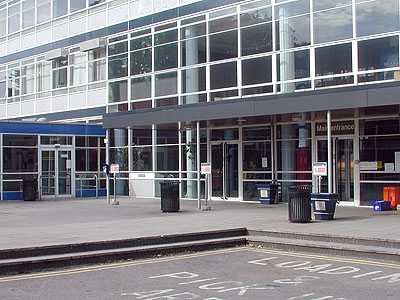
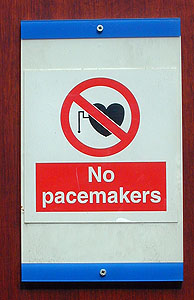
Despite the prefab architecture, Brookes is an up-and-coming university, filling and
important gap that we have also begun to notice back in Georgia:
the town that houses a major university also needs a minor university
to serve local people for whom the major one is too hard to get into.
Oxford solved the problem by upgrading the local polytechnic;
maybe Athens, Georgia, can do the same.
In the afternoon I walked around Oxford, visiting, inter alia,
Magdalen College, where I paid 3 pounds to get in
(after confirming that being a member of Cambridge University
didn't help me at all; at least it didn't cause the fee to double!).
The girl collecting the fee was reading a Latin translation of Harry Potter.
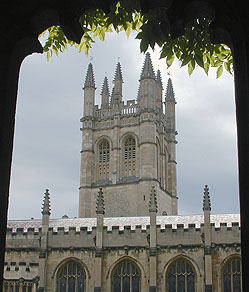
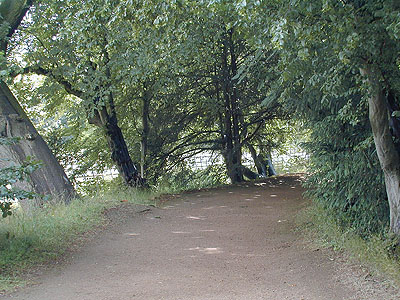
The second picture is Addison's Walk, where C. S. Lewis and
J. R. R. Tolkien used to walk and talk.
Last I did something I never got around to, back in 1976 or indeed in 1981 or 1998:
I went for a walk on Port Meadow, Oxford's village common, which has not
been plowed since Saxon times (if even then).
Contemplate it for a moment and hear the quietness of the Middle Ages.
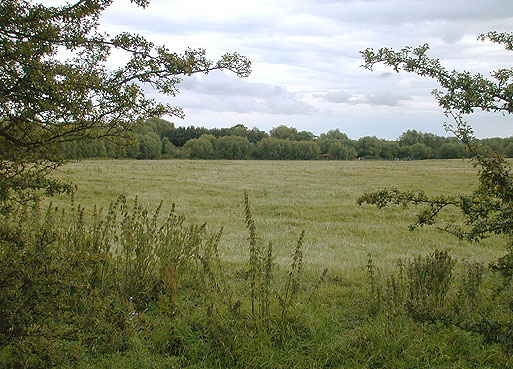

|
 |
2004
July
9
|
Conference
Today was the first day of the SANE-POWIC Conference on
The Origins of Language and Psychosis
(the name varies slightly in different documents),
and since we were in sessions all day, naturally the weather was perfect; no more rain.
Seldom have I been to an academic conference with so much to take in.
At the end of the day I bailed out from the evening entertainment and got out
and walked around, revisiting, among other places, the Bodleian Library,
where I read medieval manuscripts in 1976 and 1981.
It still has its distinctive and pleasant smell (from old stone, mainly,
and perhaps old books). A very nice, modern museum has been built in one corner
of Bod Quad; the transition from very old exterior to modern interior is a surprise.
The Holiday Inn moved me to another room, slightly larger and not at all haunted by smoke.

|
 |
2004
July
8
|
Oxford
Avid readers, if there are any left, will notice that no blog entries were uploaded
for several days. Now, like London buses, a whole series of them comes along at once.
As I write this, I plan to upload these entries from an Internet cafe, but in order
to do so, I must record them on a CD; my Jumpdrive isn't good enough.
Oxford! My first trip to England was a 6-week summer course at Worcester College,
Oxford. Since then I've only been to Oxford twice - for a few days in 1981 and a half day in 1998.
So here I am. For those who remember Oxford as a city of dreaming spires,
I supply this modern Oxonian scene:
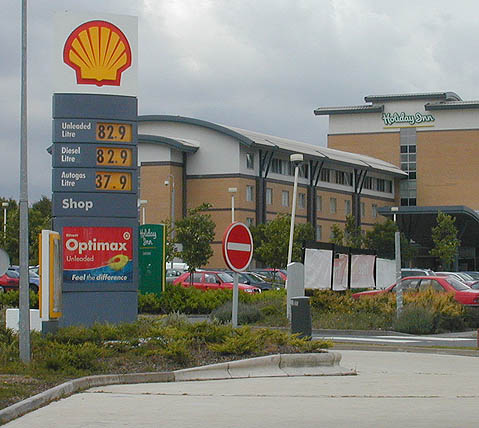
Seriously, though, the Holiday Inn at Peartree Roundabout is an excellent hotel, marred only
by a slight smell of smoke in my smoke-free room, probably attributable to the previous guest,
or maybe the air conditioning circulation. At least they're trying.
This is a free afternoon, so right after checking in, I caught a bus to the city center
and went exploring. The porter at Worcester College let me come in and look around
the college's beautiful gardens, my 1976 stomping ground... which, to my surprise, is now occupied
by a summer program from Georgia Tech. Here are some Worcester scenes, as well as Magdalen
College Tower for those who insist on some dreaming spires:
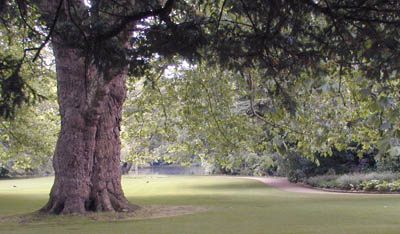
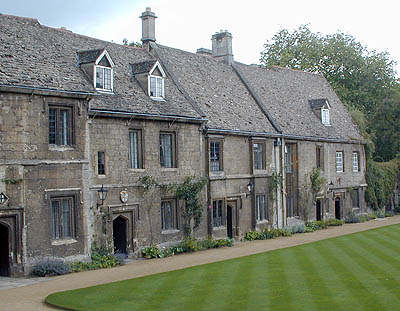
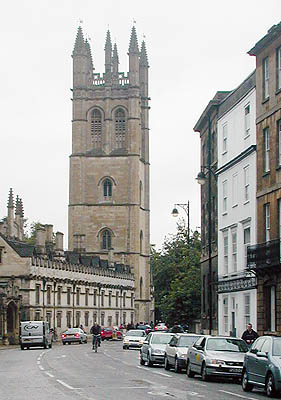
I stopped in at Pens Plus (formerly Parker's Pen Centre) to tell them that the
fountain pen that they sold me 28 years ago is still in almost daily use.
I also explored numerous bookstores - this is a city of secondhand books!
Around 4 p.m. I was coming up Longwall Street, making for Blackwell's (the largest bookstore),
when the rain came. Within minutes I was soaked. Then I browsed in Blackwell's for a couple
of hours and gradually dried out!
At 6 p.m. I attended a high-church Anglican Eucharist service at St. Mary Magdalen
(no relation to Magdalen College) - quite a contrast to last Sunday's happy-clappy Baptists.
The congregation numbered about half a dozen; for a weekday service, that is not unusual.
I find the Eucharist (Lord's Supper) to be a very focused act of worship, more so than
just singing a hymn and/or hearing a sermon. Most of Christendom has seen it this way
for the past two thousand years.
Anyone reading this material aloud should note that Magdalen is pronounced maudlin.
It means, of course, 'Magdalene' (the Biblical toponym).

|
 |
2004
July
7
|
London
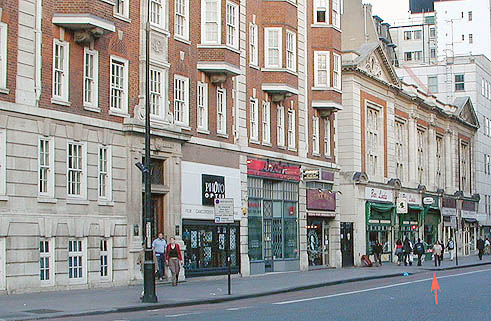 Today was our big internal meeting in London, none of whose proceedings can be published here.
Instead, here's a picture of Baker Street, where Sherlock Holmes lived.
Today was our big internal meeting in London, none of whose proceedings can be published here.
Instead, here's a picture of Baker Street, where Sherlock Holmes lived.
The arrow points to Chalfont Dry Cleaners at 222 Baker Street, the real address closest
to Holmes' fictional address of 221b. The real 221b ought to be across the street, on
the site of a large office building that belongs to the
Abbey National Building Society (a savings and loan).
The number 221b has been assigned to a Sherlock Holmes museum whose real location
puts it somewhere around 235; naturally, I don't consider it authentic.
Yesterday evening, after taking these pictures,
I had a very light dinner at a Subway sandwich shop where, doubtless, Holmes would
have gotten his sandwiches if he had known about it. Cheap food seems to be
more abundant in central London than in Cambridge.
The Ramada Plaza Regents Park gets a B.
Someone had been smoking in my smoke-free room on a smoke-free floor.
Admittedly, such things are not always under the control of the hotel.
Also, the promised in-room Internet access turns out to be a telephone jack
for a modem - not Ethernet, and useless to foreigners.
(No, I'm not going to put through an international phone call at the
hotel's rates in order to check my e-mail!)
I've used an Internet cafe
and the hotel's coin-operated Internet terminal to
handle the most urgent things.
Memorandum: USB flash drives (Jumpdrives) don't work in Internet cafes.
Late this evening, England had a rare thunderstorm and downpour.
Fortunately we were eating dinner (a gourmet meal that took over three hours)
and were not impeded.

|
 |
2004
July
6
|
Thunderflies
What do British insects eat?
For a while I was beginning to think I was part of their food chain.
Yesterday evening and again today, while I was waiting for rides outside
Addenbrooke's Hospital, swarms of skinny 1-mm-long gnat-like bugs landed
all over me and proceed to crawl around.
This afternoon I was informed that they are called thunderflies
and that they do not actually bite people, only
"itch as they crawl around." Hmmm...
Cati and I spent the morning in meetings at GlaxoSmithKline.
Then I walked around Cambridge while Bill and Cati visited
(their plan was to go punting, which I hasten to explain is a kind of boat ride,
but I think they went exploring somewhere else instead).
At 5 p.m. I was able to make a deal with a taxi driver who was about to drive
to London with a laptop computer as his only cargo, and Cati and I got a
very economical (40-pound) ride to our London hotel in a luxury van.
That's less than the train fare for two, never mind the taxis we would
have needed on both ends of the train journey.

|
 |
2004
July
5
|
A day of work
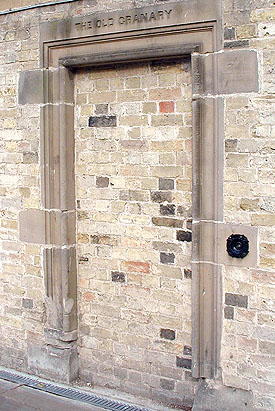 Two days ago, while walking around outside Darwin College,
Bill and I came across this
rather non-functional door.
Given its location, we've decided what it must be:
an evolutionary dead-end.
Two days ago, while walking around outside Darwin College,
Bill and I came across this
rather non-functional door.
Given its location, we've decided what it must be:
an evolutionary dead-end.
Today was spent in meetings at GlaxoSmithKline (my research sponsor); then I had dinner
with Bill and with Cati Brown, my research assistant, who had just arrived,
and we walked around.
(Among other things, we climbed the Castle Hill, where William the Conqueror built one
of his standard castles in 1068, which was gradually dismantled in the 1500s and 1600s.)
Tomorrow, more meetings, then off to London.
As an asthma sufferer, I consider smoke-free indoor air to be one of the two
great human rights victories of the 1990s (along with the collapse of Communism).
As recently as two years ago, Britain lagged behind the U.S. in the smoke-free category,
but now I think it's ahead.
Particularly gratifying is the number of restaurants that are
smoke-free de facto, with no actual prohibition being announced.
An example is La Tasca, the Spanish place were we ate this evening.
One couple lit up, and everyone gave them strange looks for as long as
they smoked, and then the air was smoke-free again.
There were no "no smoking" signs.
Not smoking has become a matter of etiquette.
At La Tasca, the waitress was delighted when I asked her for un vaso de agua in her
native language - so excited, in fact, that she soon forgot all about it and never brought
the glass of water.

|
 |
2004
July
4
|
Baptists, music, and calendars
A long day! It began with the 10:45 a.m. service at St. Andrew's Street Baptist Church
(i.e., a Baptist church named after a street which is, in turn, named after a
nearby Anglican church).
The service was long (just over 1.5 hours), fast-paced, and very youth-oriented
(but doctrinally solid, and edifying to the congregation).
Early parts of it included an interpretive dance, numerous praise choruses, and one
song with the words:
I'll reach up high,
I'll touch the ground,
I'll stomp my feet
and turn around,
I've just got to (woo woo!)
praise the Lord!
accompanied by all these movements performed by at least a few of the least shy
members of the congregation. At "woo woo!" they pretended to wave streamers
in their left hands.
The preacher delivered a good sermon on Romans 8:12-17,
and this was followed by the Lord's Supper.
Like the typical Southern Baptist communion service back home,
this involved tiny individual cups and precut pieces of bread
distributed to the congregation on trays.
But the bread was leavened, not unleavened
(hmmm, do we have an azymes controversy among Baptists?)
and the cups contained real wine, apparently much diluted,
rather than the grape juice used back home.
(The lingering Prohibition-era Baptist practice of using grape juice
in place of Jesus' wine must
amuse most of Christendom, at least those who hear about it.)
At the service I encountered my old major professor from when I was a student at Cambridge,
J. L. M. Trim, now retired.
We had a good chat and he gave me some good suggestions regarding my research.
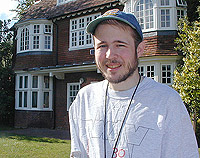 Much of the afternoon, like yesterday evening, was spent walking around
bookstores and other places with
Bill Hollingsworth, my former student, now at Cambridge doing a Ph.D.
Here you see him in front of the house where he lives at Clare Hall.
Much of the afternoon, like yesterday evening, was spent walking around
bookstores and other places with
Bill Hollingsworth, my former student, now at Cambridge doing a Ph.D.
Here you see him in front of the house where he lives at Clare Hall.
In the evening I went to Clare College Chapel to hear a performance of Handel's
Coronation Anthems (composed for the coronation of George II).
The New Cambridge Singers invited everyone interested to come and rehearse with
them earlier in the afternoon; so by the time of the actual concert, the choir
numbered more than 100, and the audience comprised about a dozen people who
were seated on benches in front of the altar, facing the huge choir (seated
in the congregation's pews) and the organ.
This is where I went to chapel services in 1977-78, so it was very familiar
but I felt that I was attending chapel backward!
[Corrections added July 12; I thank Doug Downing.]
Happy Fourth of July, Americans! This is the second time I've spent the Fourth
in England. The first was 1976, our bicentennial year.
Both times, July 4th was a Sunday. In fact, 1976 and 2004 have the same calendar
(at least as regards days of the week and month). Both are leap years.
In a normal year, the day of the week slips 1 day relative to the day of the month.
Thus, July 4th was a Sunday in 1976, a Monday in 1977, a Tuesday in 1978, and so on.
So in 28 years we've had 28 slippages, which should total exactly four weeks...
...except that we've also had some Leap Year Days, each of which causes a 1-day shift
in the same direction.
It happens that between the beginning of 1976 and the beginning of 2004, we've had
7 occurrences of Leap Year Day (not counting the one that
occurred after the beginning of 2004).
Thus the day of the week has slipped forward 28 days plus 7 days, giving a total of 35.
This is exactly five weeks, which is why the day of the week for any calendar date
in 2004 is the same as in 1976.

|
 |
2004
July
3
|
En route
Friday, 6:43 p.m. EDT. I'm in the departure lounge in Atlanta.
The world's busiest airport
was surprisingly easy to negotiate.
Check-in (business class) was instantaneous; I was allowed to lock my luggage;
and the security lines looked formidable but actually took 19 minutes.
Saturday, very early: In-the-air astronomy this time consisted only
of watching the full moon rise and culminate low in the south, with Fomalhaut
to the left of it. On a flight to England in 1981 I saw a spectacular aurora borealis.
Possibly appropriate music: Nessun dorma, performed by Opera Band...
on the plane's audio system... while wishing I could sleep.
Saturday, 8:55 a.m. BST. England!
The English countryside always looks tidier than its American counterpart,
and the land around Gatwick Airport is particularly pleasing.
Also, a digital camera is great for taking pictures through airplane
windows because "auto levels" in Photoshop compensates for the loss
of contrast.
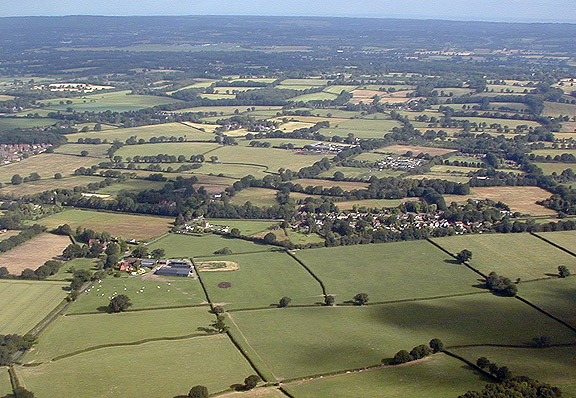
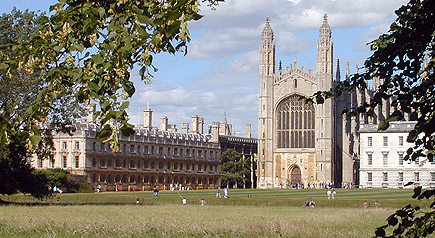 Cambridge is a place of great beauty. Here is its
most famous scene, Clare College and King's College Chapel, as rendered by my
Nikon Coolpix 800.
Cambridge is a place of great beauty. Here is its
most famous scene, Clare College and King's College Chapel, as rendered by my
Nikon Coolpix 800.
But connoisseurs of Cambridge will note
that Woolworth's and Heffers Plus (formerly Heffers Paperback Shop) have vanished.
That means the town no longer has a fountain pen shop as far as I can tell.
And is Woolworth's still in business anywhere?
As recently as 2002, the Cambridge Woolworth's was remarkably like the American
"dime stores" of the 1960s.
Browsing in bookshops, I learned that Veterinary Record, 1972,
apparently contains an article on the treatment of common disorders
of Brunus edwardii (teddy bears).

|
 |
2004
July
2
|
Miscellany
 Tonight I'll be flying to England.
Tonight I'll be flying to England.
At the right is a live webcam image from the
top of the Cambridge University Library tower.
(Click on it for particulars.)
The camera swings around a lot in the wind,
but maybe it will aim down on Clare College
(where I was a graduate student in 1977-78)
or even catch an image of me walking by.
The graphics problem that I wrote about on
June 23
turns out to be specific to Internet Explorer.
Opera sensibly does not try to enlarge the pictures, only the type.
You'd think the "Smart Image Dithering" option in Internet Explorer would
address exactly the problem I was having, but it doesn't seem to have any effect.
Nor does updating the video driver.
A major upgrade of Windows XP, especially Internet Explorer, is due in a few weeks.
Here is
Paul Thurrott's very lucid explanation of what's coming.
He points out that the problem with the present Internet Explorer is simply that
drive-by downloading can't be completely disabled.
Web pages are allowed to give you software - automatically - to help you view them.
The trouble is, this ability can be used for evil purposes,
such as capturing your keystrokes and sending them to someone who wants
your passwords.
Partly, Microsoft was just naive.
And partly, society failed us by not addressing the problem of Internet crime
ten years ago.
Back then, the stakes were thought to be low, and authorities viewed spam and viruses
as mere disputes among hobbyists.
Not only that, but the computer elite proudly defended their "electronic frontier"
where only the strong were safe.
The one good thing about the current Internet crime wave
is that we are getting some of the re-engineering that we've needed for a long time.
The new Internet Explorer will require some people to redesign their web pages.
And it will be popular enough that they'll actually feel compelled to do it.
More news after I land in fair Albion; don't expect an entry every day,
but I will continue posting.

|
 |
2004
July
1
|
Farewell to FTP
FTP, or File Transfer Protocol, is a time-honored (and not very safe) way to
transfer files over the Internet.
It's not safe because neither the files nor the passwords used to access them are
encrypted; anyone with a packet sniffer could read the user names and passwords.
But many web hosts still use FTP to upload the files, because there's no widely
agreed-upon alternative, and because if the passwords are used only rarely (like once
a month rather than once an hour), the chance of interception is still relatively low.
(Yes, I know about SFTP. But until SFTP servers and clients are freely distributed,
it won't be the standard. More likely, something a lot more Web-like will replace FTP
entirely.)
Anonymous FTP is FTP without a password, for sharing files with the whole world.
Before the World Wide Web, anonymous FTP was a very popular way for people,
companies, and institutions to make file libraries available.
Traditionally, one directory, called pub (public), was made
readable by everyone.
At least one of the great anonymous FTP libraries,
WUSTL
(Washington University of St. Louis),
is still there, though its pub directory now seems to contain only Linux.
Nowadays, you can explore an FTP library with your web browser, but in the "good old
bad old days," FTP-ing was a command-line process that looked like this:
aiunix2% ftp ftp.wustl.edu
Connected to wuarchive.wustl.edu.
220 wuarchive.wustl.edu FTP server (Version wu-2.6.2(2) Wed Apr 10 18:3
Name (ftp.wustl.edu:mc): anonymous
331 Guest login ok, send your complete e-mail address as password.
Password:
230-
230-Welcome to wuarchive.wustl.edu
230-Local Time: Wed Jun 30 18:26:23 2004
230-
230-You are user 20 of 100.
230-
230-
230 Guest login ok, access restrictions apply.
ftp> quote pasv
227 Entering Passive Mode (128,252,19,2,195,9)
ftp> cd pub
250 CWD command successful.
ftp> cd linux
250 CWD command successful.
ftp> ls -al
200 PORT command successful.
150 Opening ASCII mode data connection for /bin/ls.
total 9
drwxrwxr-x 3 1005 archive 512 Dec 8 2003 .
drwxrwxr-x 3 20025 other 512 Jan 16 2003 ..
lrwxrwxrwx 1 1005 archive 38 Jan 16 2003 daemons -> ../..
lrwxrwxrwx 1 1005 archive 36 Jan 16 2003 devel -> ../../m
drwxrwxr-x 4 1005 archive 512 Jun 24 20:37 distributions
lrwxrwxrwx 1 1005 archive 35 Jan 16 2003 docs -> ../../mi
lrwxrwxrwx 1 1005 archive 37 Jan 16 2003 kernel -> ../../
lrwxrwxrwx 1 1005 archive 35 Jan 16 2003 libs -> ../../mi
lrwxrwxrwx 1 1005 archive 36 Jan 16 2003 utils -> ../../m
226 Transfer complete.
ftp>
|
You would then use commands to explore the directory structure, trusting your host
to use meaningful names and give you an occasional Contents or ReadMe file.
Cognoscenti will recognize quote pasv as an anachronism; it's something
we have to do nowadays to get FTP to be compatible with firewalls.
Well... As of today, the AI Center no longer runs an anonymous FTP site.
The reason?
Almost all of our users were script kiddies trying to break in!
Every single one of them was successfully turned away, but we were getting
about a thousand attempts a month.
Mostly, what they'd try to do is open hundreds of connections at the same time,
in hopes of tying up the server and keeping everybody else out.
Sometimes they'd type strange commands that were supposed to crack security
(and might have worked on some other FTP server a long, long time ago).
Our file library is now at www.ai.uga.edu/ftplib.
We invite you to use your web browser and explore it.

|
 |
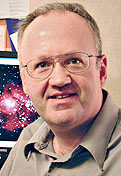

![]()
 Twenty-two years ago today, July 25, 1982,
Melody and I got married at her church in Winder, Georgia.
We have been (and still are) a very happy couple.
Actually, neither of us could imagine being married to anyone else.
Twenty-two years ago today, July 25, 1982,
Melody and I got married at her church in Winder, Georgia.
We have been (and still are) a very happy couple.
Actually, neither of us could imagine being married to anyone else.
 I'm on vacation this week and not writing blog entries regularly, but here's
tonight's photographic triumph.
There was an intense thunderstorm about 30 miles south of us, but no lightning
in the immediate area - hence a good opportunity to watch a thunderstorm without
being more directly involved than I would want!
I'm on vacation this week and not writing blog entries regularly, but here's
tonight's photographic triumph.
There was an intense thunderstorm about 30 miles south of us, but no lightning
in the immediate area - hence a good opportunity to watch a thunderstorm without
being more directly involved than I would want!
 Update, 9:51 p.m.: Look carefully at this election result,
which is apparently going to require two runoffs.
Update, 9:51 p.m.: Look carefully at this election result,
which is apparently going to require two runoffs.
 Like most people over 45 years old, I suffer from presbyopia, which means
that the lenses of my eyes have lost most of their focusing range.
This is not a disease; it's a natural result of aging.
Many presbyopia sufferers don't realize what's happening; they conclude
that their "eyes are growing dim" or that they're going blind.
Like most people over 45 years old, I suffer from presbyopia, which means
that the lenses of my eyes have lost most of their focusing range.
This is not a disease; it's a natural result of aging.
Many presbyopia sufferers don't realize what's happening; they conclude
that their "eyes are growing dim" or that they're going blind.
 I've been busy... but last night was the first clear night in many weeks, and I was finally able
to get my telescope out and try out a new eyepiece that I bought about 6 weeks ago.
I've been busy... but last night was the first clear night in many weeks, and I was finally able
to get my telescope out and try out a new eyepiece that I bought about 6 weeks ago.









 Today was our big internal meeting in London, none of whose proceedings can be published here.
Instead, here's a picture of Baker Street, where Sherlock Holmes lived.
Today was our big internal meeting in London, none of whose proceedings can be published here.
Instead, here's a picture of Baker Street, where Sherlock Holmes lived.
 Two days ago, while walking around outside Darwin College,
Bill and I came across this
rather non-functional door.
Given its location, we've decided what it must be:
an evolutionary dead-end.
Two days ago, while walking around outside Darwin College,
Bill and I came across this
rather non-functional door.
Given its location, we've decided what it must be:
an evolutionary dead-end.
 Much of the afternoon, like yesterday evening, was spent walking around
bookstores and other places with
Bill Hollingsworth, my former student, now at Cambridge doing a Ph.D.
Here you see him in front of the house where he lives at Clare Hall.
Much of the afternoon, like yesterday evening, was spent walking around
bookstores and other places with
Bill Hollingsworth, my former student, now at Cambridge doing a Ph.D.
Here you see him in front of the house where he lives at Clare Hall.

 Cambridge is a place of great beauty. Here is its
most famous scene, Clare College and King's College Chapel, as rendered by my
Nikon Coolpix 800.
Cambridge is a place of great beauty. Here is its
most famous scene, Clare College and King's College Chapel, as rendered by my
Nikon Coolpix 800.
